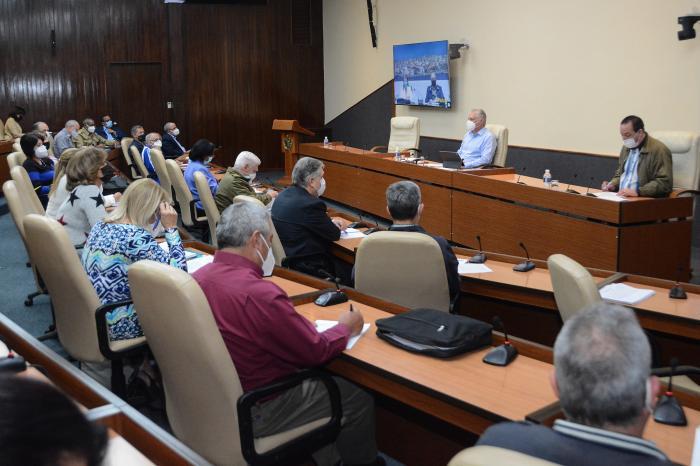
Cuban mathematicians and epidemiologists believe that the country is entering the peak of the current wave of COVID-19 infections, according to forecast models presented January 18 during the weekly meeting of Party First Secretary and President of the Republic Miguel Díaz-Canel Bermúdez with experts from the Ministry of Public Health (Minsap) who have guided scientific and technological innovation in the battle against the coronavirus for almost two years.
Dean of the Mathematics and Computer Science Department at the University of Havana Raul Guinovart Diaz noted that current forecasts are more encouraging than those of past weeks, although the country continues to face a difficult situation.
Although he acknowledged that the modeling issue may be controversial, he pointed out that the studies indicate that Cuba is entering the peak of the current wave of new infections, which will subsequently begin to decline.
Díaz-Canel commented that, compared to what is happening around the world following the emergence of the Omicron variant, the increase of cases in Cuba has been a slower process, the change less dramatic. He recalled that the average of 3,000 to 3,500 cases per day has been maintained, while other forecasts had projected more than 6,000 a day.
The number of new cases reported everyday is approaching the number of medical discharges granted, Guinovart Díaz stated, which seems to indicate that the epidemic is being controlled. Plus, growth has slowed in recent days. We must remain very attentive to the situation, but the trend would imply some level of control in the coming weeks, he stated.
This same opinion was shared by professor Pedro Mas Bermejo, vice-president of the Cuban Hygiene and Epidemiology Society, who pointed out that the forecast prepared by the University of Sancti Spiritus and presented by Guinovart Díaz, has proven accurate over the last 20 days, noting, "The agreement has been very close."
As long as we continue to administer boosters and increase the percentage of the population vaccinated, the control being projected will be possible, he said, adding, “I would dare to say that we are in a stage of control, all the data and international comparisons lead us to this idea.”
Dr. José Raúl de Armas Fernández, head of the Ministry’s Department of Communicable Diseases, commented that the provinces of Granma and Santiago de Cuba have not yet reached the number of confirmed cases they could see; they are below the levels of transmission we have today across the rest of the country.
But this will not lead to another significant peak, beyond the forecasts presented, Dr. Armas said, agreeing that we are entering a period of plateau, before a decline begins, which can be assured if we continue to advance in the administration of boosters.
VACCINATION MUST CONTINUE
Ileana Morales Suarez, director of Science and Technological Innovation at Minsap, provided an update on national vaccination efforts, and reported that 92.5% of Cuba's eligible population - not including children under two years of age, those living outside the island and those suffering from terminal illnesses - has completed the full vaccination regimen.
Morales indicated that some 45.5% of the population has received a booster, with the highest numbers in Havana (1,150,763 persons), Santiago de Cuba (406,412) and Holguin (330,694), adding that the vaccines Soberana Plus and Soberana 02, as well as Abdala, are being administered nationwide. In addition, Soberana 01 and Mambisa are being used as boosters in smaller numbers, as part of ongoing clinical trials.
She noted that already more than four million boosters have been administered, and the delivery of vaccines to provinces continues, in order to complete the campaign this month.
MAMBISA IS ON THE WAY, TOO
During the meeting, information was also shared on the progress of clinical studies with the candidate vaccine Mambisa, which is administered nasally.
Dr. Gerardo Guillén Nieto, director of Biomedical Research at the genetic Engineering and Biotechnology Center (CIGB), explained that Mambisa is currently being studied in two different Phase 2 clinical studies. One is investigating its use as a booster with 2,220 individuals who received three doses of Mambisa and another with a group recently recovered from COVID-19, which is still accepting volunteer participants at the Hermanos Ameijeiras Hospital in Havana, the Raúl Díaz Polyclinic in Pinar del Río, and the Manuel Ascunce Hospital in Camagüey.
The researcher explained that in the Phase 1 study of the Mambisa candidate vaccine with 120 individuals, three different nasal administration devices were tested, all with very good results. The one which can be produced in Cuba was selected for Phase 2, he said, thus guaranteeing its availability and sustainability.
In this phase of the trial, he explained, the criterion for success of the candidate vaccine was a fourfold or greater increase in the titers of specific IgG antibodies, and an even more significant increase was observed. Once again, he said, the ability of nasally administered vaccine to induce an immune response at a systemic level was demonstrated, with antibodies in the blood and the mucosa, where the virus enters the organism.
When Phase 2 studies are completed, Mambisa will be submitted to Cuba’s regulatory agency Cecmed for emergency use authorization, he said, and will be one of the 11 vaccines administered nasally that are being studied worldwide to combat COVID-19.















